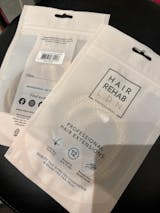
The Ultimate Guide to Hair Extensions: Types, Application Methods, and Maintenance
We’ve all seen hair extensions that are less than discreet, right? The ultimate goal is to achieve a flawless, natural look where no one can tell you’re wearing them. With the right hair extensions for your hair type, you’ll be turning heads for all the right reasons! This guide will walk you through the various types of hair extensions, their application methods, and the best maintenance tips to keep them looking stunning.
Types of Hair Extensions and Application Methods
1. Tape-In Extensions
Perfect for: Fine or Thin Hair
Tape-in extensions feature flat wefts that are applied close to the root using medical-grade adhesive. Their thin design ensures a natural blend, even for those with very fine hair.
-
Application: Installed by sandwiching small sections of your natural hair between two extension wefts.
-
Maintenance: Needs repositioning every 6-8 weeks as your hair grows by stripping the old adhesive tape and replacing it with fresh adhesive tape.
-
Longevity: With proper care, Hair Rehab London’s tape extensions can last up to 12 months.
2. Nano Extensions
Perfect for: Short Hair
Nano extensions use small, clear silicone-tipped bonds applied with tiny micro rings. This makes them an ideal choice for those with shorter hair who want a discreet finish.
-
Application: Individual extensions are secured with nano rings, ensuring they’re hidden within your natural hair.
-
Maintenance: Requires refitting every 8-12 weeks.
-
Longevity: Lasts up to 12 months with proper care.
3. Stick Tip Extensions (Micro Rings)
Perfect for: Thick or Coarse Hair
Stick tip extensions are applied using micro rings, making them a strand-by-strand method suitable for thicker hair types. They create a secure hold while maintaining a natural appearance.
-
Application: Individual strands are attached with micro rings, requiring 100-150 bonds for most clients.
-
Maintenance: Refit every 8-12 weeks.
-
Longevity: Can last up to a year with proper maintenance.
4. Hot Fusion / Prebond Extensions
Perfect for: Thick or Coarse Hair
Hot fusion extensions are bonded to natural hair using keratin tips and a heat gun. They’re a great option for those with coarse hair textures looking for long-lasting results.
-
Application: Keratin bonds are melted and fused to small sections of natural hair.
-
Maintenance: Requires professional removal and reapplication every 8-12 weeks.
-
Longevity: Lasts up to 12 months with the right care.
5. Clip-In Extensions

Perfect for: Damaged or Versatile Styling
Clip-ins are the ultimate temporary solution, offering instant volume and length without commitment. They’re especially suited for those with damaged hair who want to give their strands a break from permanent extensions.
-
Application: Clips are securely attached to sections of your natural hair and can be easily removed.
-
Maintenance: Minimal care required. Store properly and clean as needed.
-
Longevity: With occasional use, clip-ins can last years.
6. Weft Extensions (Sew-In)
Perfect for: Thick Hair
Weft extensions involve sewing a curtain of hair onto tightly braided sections of your natural hair. This method works best for thick hair types that can support the weight.
-
Application: A professional braids your natural hair or will place micro rings into your hair and sews the weft onto the braids / rings.
-
Maintenance: Re-tightening needed every 6-8 weeks.
-
Longevity: High-quality wefts can last up to a year with proper care.
How to Apply Hair Extensions
-
Consult a Professional: Always consult a certified extensionist who can recommend the best type for your hair.
-
Ensure a Proper Match: Extensions should blend seamlessly with your natural hair colour and texture.
-
Follow Instructions: If using temporary extensions like clip-ins, ensure you’re clipping them securely and evenly for a natural look.
-
Seek Expert Installation: For permanent options, professional application is crucial to avoid damage and ensure durability.
Hair Extension Maintenance Tips

-
Gentle Washing: Use sulphate-free shampoo and conditioner to prevent stripping the extensions of moisture.
-
Avoid Heat Damage: Use heat styling tools sparingly (heatless curlers are perfect for hair extensions) and always apply a heat protectant
-
Brush Carefully: Use a detangling brush or loop brush designed for extensions to avoid pulling or snagging.
-
Protect While Sleeping: Tie hair in a loose braid or ponytail and sleep on a silk pillowcase or use a silk hair wrap at night to reduce friction.
-
Regular Appointments: Book maintenance appointments with your extensionist to ensure the extensions stay secure and blend seamlessly.
Why Choose Hair Rehab London Extensions?
At Hair Rehab London, we offer a wide range of extensions to suit all hair types and preferences:
-
Lengths: Available in 14”, 18”, 20” and 22”. Longer lengths can be sourced for bespoke orders.
-
Thickness: Options to suit fine, average, and thick hair textures.
-
Variety: Choose from clip-ins, tape-ins, wefts, nano extensions, and more.
-
Instant Hairpieces: Explore our affordable ‘Instant’ range featuring ponytails, buns, plaits, and wigs for quick and easy styling.
Still Unsure?
Use our Personal Colour Match Service to upload a photo, and our team will help you find the perfect extensions for your hair type and goals. Ready to transform your look? Explore our range of extensions and hairpieces today!
Achieve the hair of your dreams with Hair Rehab London—because your hair deserves it!

